Ho Chi Minh (or is it Saigon?) and the trials of Tet
Ho Chi Minh City may not be the capital of Vietnam but it is its biggest and most prosperous city, with a population of 9.5 million. Before 1976 HCMC was called Saigon and many Vietnamese still refer to it by the old name. After some discreet enquires of the locals it seems that either name is acceptable.
We arrived in Vietnam in the early evening but fortunately a cab into the middle of town was only 45 minutes. We had a great taxi driver who told us all the places we should visit and the foods we should eat – all while showing us pictures on his mobile phone and driving at the same time.

Our hotel was definitely not one of the best on our trip with no window but at least it was quiet at night and situated in the central District 1 near to all the tourist must sees.

We had booked our trip to Vietnam before learning about the Tet holiday which was due to start soon after we arrived. Tet is the biggest holiday of the year in Vietnam and is the celebration of the Chinese New Year. A lot of businesses shut for a week around this time and most of the growing Vietnamese middle class go on holiday.
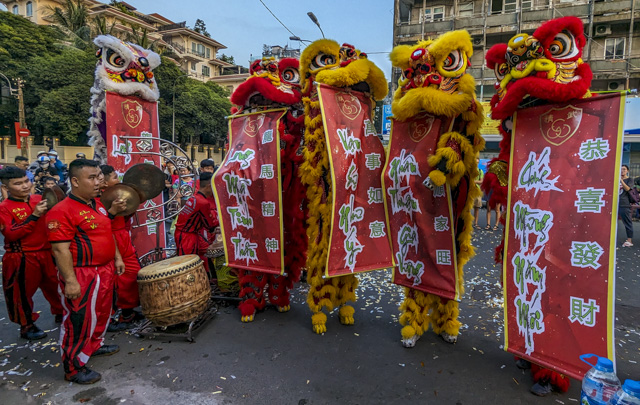
The upshot of Tet was that lots of tours weren’t running and many shops, restaurants and bars were closed. There were also huge numbers of Vietnamese tourists around making some places unbelievably crowded. Not the best for our first week in Vietnam.

On the plus side however, there were huge numbers of decorations around the city, masses of flowers everywhere (the Vietnamese love their flowers) and there was a real party atmosphere in the lead up to the celebrations, which are usually spent with their families. A massive open air flower market opened up in District 1 to provide flowers for people’s Tet decorations.

A major road in the centre of District 1 had been pedestrianised and decorated with flowers and dragons and there were signs everywhere saying “Chuc Mung Nam Moi” or “Happy New Year”.

Despite all of this we did manage to see some of the city. Our first port of call was the Independence Palace, which served as the seat of government between 1962, when it was built and 1975 when the puppet government in the South was overthrown by North Vietnamese forces to conclude the American war. (Unsurprisingly the war with America that is called the Vietnam war in the West is referred to as the American war in Vietnam).

The building is in a Modernist style but the interior has been preserved in a gloriously 70’s style !
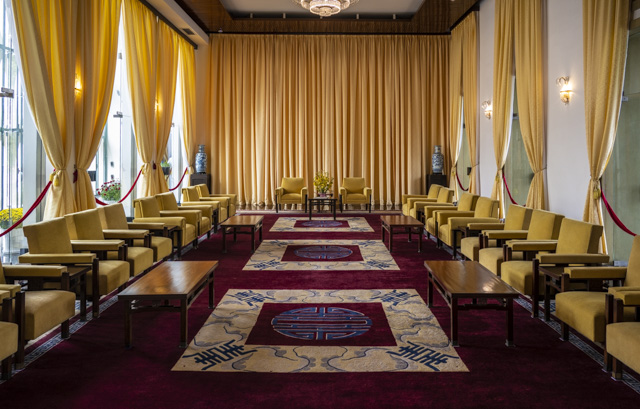
It feels like it could be a set for a Bond film and even has an underground bomb shelter with communication equipment from the 70’s and a situation room with maps of troop movements from the war.
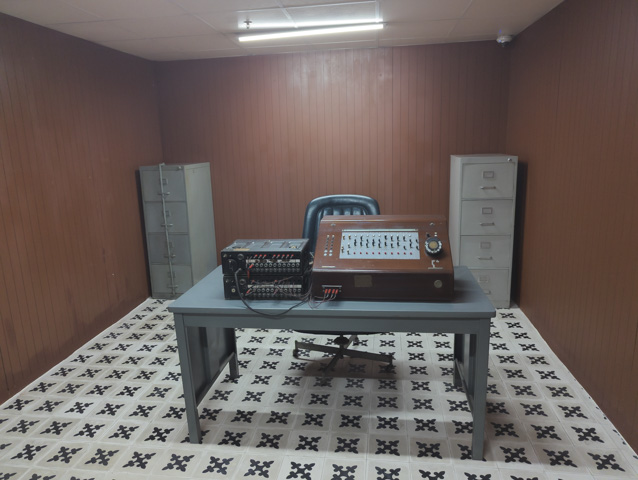
After visiting the Palace our next stop was the highly thought provoking War Remnants Museum. This museum showcases the Vietnamese side of the American war and focuses on the atrocities committed by the American forces during the war. It also has a wing dedicated to the prison systems in the South of Vietnam where the North Vietnamese soldiers were incarcerated and the various tortures that were employed.

When trying to understand history it is important to realise that every source of information is biased depending on who is telling the story and there were clearly atrocities on both sides. However, the facts of the American war are horrendous with over 7.5million tons of bombs dropped on Vietnam by the Americans and their allies and 13 million gallons of Agent Orange (a herbicide designed to clear forested areas) sprayed in Vietnam leading to devastation of the environment and cancers, birth defects and neurological problems in the population for years to come.

This is a sobering as well as thought-provoking museum and well worth a visit.
In the evening we jumped on a bus tour of the city which drove us around and gave us a great view of the skyline of Saigon. It’s a big modern city with lots of skyscrapers. At night they are all lit up with many having lightshows on their exteriors.

One of the most popular tours from Ho Chi Minh is to visit the Cu Chi tunnels. These are a preserved example of the tunnels that the Viet Cong lived in and used as a base to strike against American troops in the war.
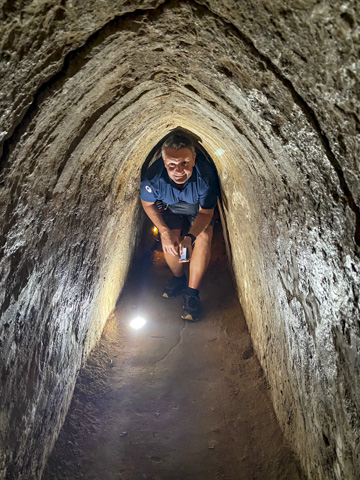
The half day trip to visit them is rounded out with a stop-off at an arts and crafts factory, providing work to those born with disabilities due to Agent Orange, and rather ironically, at the other end of the scale, a shooting range where you can shoot, among others, ak-47s and M16s.
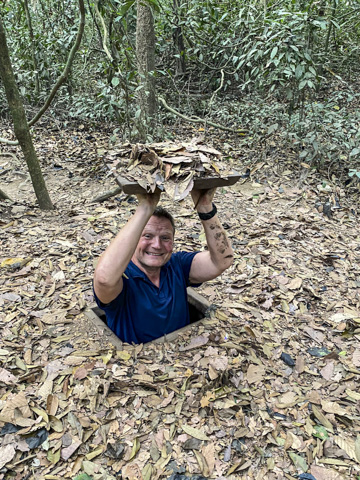
The tunnels that are open to tourists have been stabilised and enlarged for our western bodies to get down them. The original tunnels were absolutely tiny and with the heat and humidity in this part of the world must have been incredibly uncomfortable.

The whole tunnel complex was incredibly well hidden with ventilation pipes hidden in fake termite mounds. The area was also heavily booby trapped with traps designed to severely injure the American troops.

The tour was an interesting history lesson and a good insight into how horrific the war must have been for both sides.

From Ho Chi Minh we also did a two day trip out to the Mekong delta which although only a 100km away is a good three hour drive on the congested roads.

It was a really interesting trip that gave us an insight into the way of life in the delta which is of course based around the water ways which are branching with big and small channels.

Fishing is obviously a very important activity in this area and we visited a floating fish farm which had a number of pens with both fish for consumption and ornamentals. All of this in the middle of one of the biggest channels of the Mekong Delta.

We also visited some of the narrower waterways and took a boat trip in a traditional hand paddled boat but for me, the most interesting part of the tour, was the trip to the Cai Rang floating market. This is close to the town of Can Tho and is different from the floating market we visited in Thailand as it’s a wholesale market.

On each of the boats a pole with a sample of the goods that they sell is raised aloft to show what they deal in. Each of the boats tends to deal in only one type of product.

The action in the market happens early in the morning and we visited first thing but even then it was beginning to wind down. It all starts at 3 or 4am so by 7am it’s almost over but we got a glimpse of the action and really enjoyed the experience.
